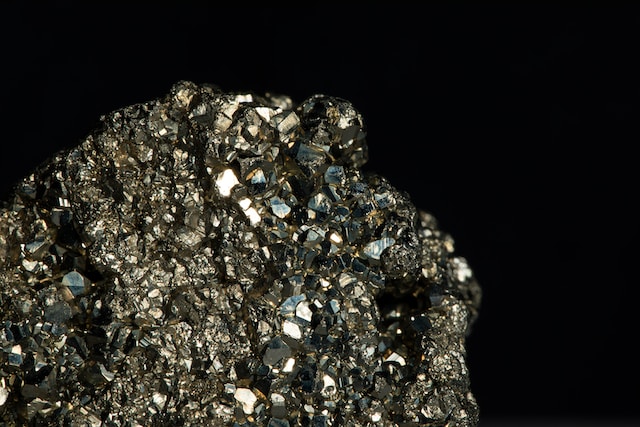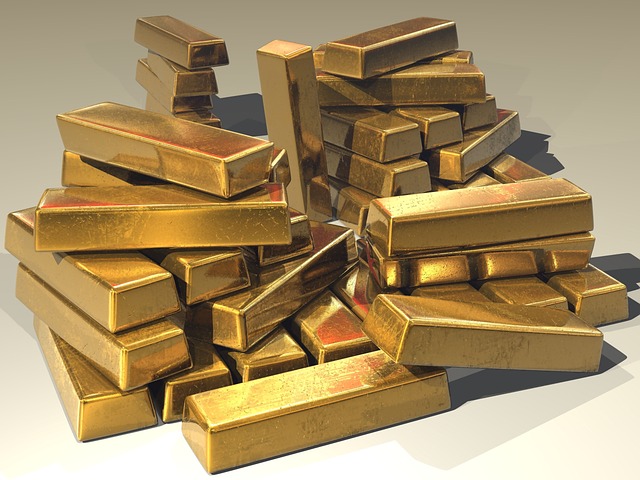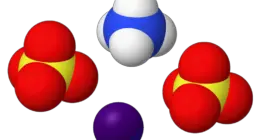Pyrite and gold are both minerals that are often found together in rocks. Gold is a more valuable mineral than pyrite. It is often used in jewelry and other decorative items. Pyrite, on the other hand, is not as valuable as gold and is mostly used for industrial purposes.Another difference between pyrite and gold is their color. Gold is a yellowish color, while pyrite is a silvery-black color.
Pyrite
(Photo by Calvin Chai on Unsplash )

Pyrite is a common mineral that is also known as “fool’s gold” due to its shiny, metallic appearance, which can resemble gold to the untrained eye. It is composed of iron sulfide and has a brassy yellow color with a metallic luster. While it is often mistaken for gold, pyrite has little to no value as a precious metal and is primarily used as a source of sulfur and as a decorative stone. It can be found in a variety of geological settings, including sedimentary, igneous, and metamorphic rocks.
Gold
(Photo by Jingming Pan on Unsplash )

Gold is a chemical element with the symbol Au (from Latin: aurum) and atomic number 79, making it one of the higher atomic number elements that occur naturally. In a pure form, it is a bright, slightly reddish yellow, dense, soft, malleable, and ductile metal. A relatively rare element, gold is a precious metal that has been used for coinage, jewelry, and other arts throughout recorded history. In the past, a gold standard was often implemented as a monetary policy, but gold coins ceased to be minted as a circulating currency in the 1930s, and the world gold standard was abandoned for a fiat currency system after 1971. A total of 197,576 tonnes of gold exists above ground
Gold Vs. Pyrite – Key differences
- Gold is much rarer than pyrite and is found in only trace amounts in most rocks. Pyrite, on the other hand, is quite common and can be found in large deposits.
- Gold is often found in nature alongside quartz. Pyrite, on the other hand, is usually found in sedimentary rocks such as shale or coal beds.
- Gold is softer than pyrite and can be scratched with a knife. Pyrite, on the other hand, is harder and cannot be scratched with a knife.
- Gold is malleable, meaning it can be hammered into thin sheets. Pyrite, on the other hand, is brittle and will break if struck with a hammer.
- When exposed to air, gold will not tarnish or rust. Pyrite, on the other hand, will oxidize and form sulfuric acid when exposed to air and water.
The physical differences between pyrite and gold
Pyrite and gold have several physical differences that make them distinguishable from one another. Here are a few key differences:
Color: While both pyrite and gold have a yellow color, they have distinct shades of yellow. Pyrite is usually a brassy yellow color, while gold is a more subdued, buttery yellow.
Hardness: Gold is a relatively soft metal, with a hardness of about 2.5 to 3 on the Mohs scale. Pyrite, on the other hand, is a mineral with a hardness of about 6 to 6.5 on the Mohs scale, making it much harder than gold.
Density: Gold is much denser than pyrite, with a specific gravity of about 19.3 compared to pyrite’s specific gravity of about 5.0 to 5.2.
Shape: Pyrite crystals often have a cubic or octahedral shape, while gold is typically found as nuggets, flakes, or grains.
Streak: The streak of a mineral is the color of the powder it leaves behind when rubbed on a hard surface. Pyrite has a greenish-black streak, while gold has a yellow streak.
These differences make it possible to distinguish between pyrite and gold, even though they can look similar to the naked eye.
The chemical differences between pyrite and gold
Gold is a chemical element with the symbol Au (from Latin: aurum) and atomic number 79, making it one of the higher atomic number elements that occur naturally. In a pure form, it is a bright, slightly reddish yellow, dense, soft, malleable, and ductile metal. A relatively rare element, gold is a precious metal that has been used for coinage, jewelry, and other arts throughout recorded history. In the past, a gold standard was often implemented as a monetary policy, but gold coins ceased to be minted as a circulating currency in the 1930s, and the world gold standard was abandoned for a fiat currency system after 1971. A total of 197,576 tones of gold exists above ground, as of 2019.
Pyrite is an iron sulfide with the chemical formula FeS2 (iron(II) disulfide). Pyrite is considered the most common sulfide mineral. Its main component is iron. It also contains sulfur in high proportions (about 46%). Pyrite’s metallic luster and pale-to-normal brass yellow hue have earned it the nickname fool’s gold because of its similarity to real gold.
Where are pyrite and gold found?
Pyrite and gold are found in different geological settings and have different distributions around the world. Here are some common locations where pyrite and gold can be found:
Pyrite:
- Sedimentary rocks: Pyrite is commonly found in sedimentary rocks such as shale, sandstone, and limestone.
- Igneous rocks: Pyrite can also be found in igneous rocks such as granite, where it may form as a result of high temperatures and pressures during the rock’s formation.
- Hydrothermal veins: Pyrite is often found in hydrothermal veins, which are formed by the movement of hot fluids through fractures in rocks.
- Coal deposits: Pyrite is sometimes found in coal deposits, where it can cause problems such as acid mine drainage.
Gold:
- Veins: Gold is often found in quartz veins that run through igneous and metamorphic rocks.
- Placer deposits: Gold can be found in placer deposits, which are formed by the accumulation of gold particles in rivers and streams.
- Witwatersrand Basin: The Witwatersrand Basin in South Africa is a major gold-producing region that has produced over 40% of the world’s gold.
- Carlin-type deposits: Carlin-type deposits, which are found in Nevada and other parts of the western United States, are a type of sediment-hosted gold deposit that has produced significant amounts of gold.
Pyrite and gold have different geological distributions and are found in different types of rocks and deposits. While pyrite has industrial uses, gold is highly valued for its beauty and rarity, and is often used for jewelry and investment purposes.
How to tell the difference between pyrite and gold
When it comes to differentiating between pyrite and gold, there are a few key things that you can look for. To the untrained eye, they may appear to be similar in color and luster, but there are some distinct differences between the two.
Here are a few ways to tell the difference between pyrite and gold:
- Pyrite is often more brittle than gold.
- Gold is a softer metal than pyrite, so it will show signs of wear more easily.
- Pyrite has a slightly greenish hue, while gold is more of a yellowish color.
- You can test the hardness of each mineral with a Mohs hardness test kit. Gold will scratch more easily than pyrite.
What is fools gold?
Fool’s gold is an impostor – a lure that promises great rewards, but delivers nothing. This name is given to minerals that have a metallic luster and are often mistaken for gold. Pyrite is the most common fool’s gold mineral. It has a brassy-yellow color and glittery metallic luster that is often mistaken for real gold.
Is it safe to wear pyrite?
Pyrite is a naturally occurring mineral that is used in a variety of jewelry and other decorative items. While pyrite is safe to wear, it is important to be aware of its potential dangers. Pyrite contains sulfur, which can cause skin irritation if it comes into contact with the skin. In addition, pyrite is flammable and should not be worn near open flames or other sources of heat.
What is pyrite used for?
Pyrite has several industrial uses, although it is not as valuable as gold. Here are some common uses of pyrite:
Sulfur: Pyrite is a significant source of sulfur, which is used in the production of sulfuric acid, one of the most widely used industrial chemicals.
Iron: Pyrite is a source of iron and can be used to make iron and steel products.
Jewelry and ornaments: Pyrite is sometimes used as a substitute for gold in jewelry and other decorative objects, due to its metallic luster and brassy color.
Electronics: Pyrite is sometimes used in electronic components such as microchips and circuit boards.
Fossils: Pyrite can sometimes form around fossils, creating a cast of the fossil that can be preserved for millions of years.
Featured Image By – Steve Bidmead from Pixabay









